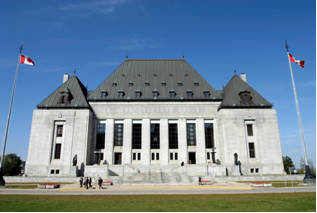
Supporting man-woman marriage
Same-sex marriage supporters say there are no reasons to support a gender requirement in marriage. Are they right?
July 20, 2013 marks eight years since the legalization of same sex marriage in Canada. Alongside this, the recent decision to overturn the Defence of Marriage Act (DOMA) in the United States has resulted in more than the usual amount of marriage-related commentary.
The commentary is split, insofar as some journalists are out celebrating, while others merely emphasize that nothing has changed. For an example of celebration, see the Vancouver Province with “same-sex marriage makes Canada better.”1 John Moore, on the other hand, writing in the National Post, discussed the normalcy: “Eight years after SSM came to Canada, the sky has not fallen… The reason for the West’s evolution toward support for SSM is clear: As people see gay people going about their ordinary daily lives and aspiring to the same things everyone else wants for themselves and their children, they quickly run out of arguments against an evolution that does no damage.”2
Who could possibly continue to hold on to the notion that marriage is for men and women? Indeed, if public opinion polls are correct, only three in ten Canadians do.3 The implication of Moore’s statement is that this is a thoughtless position, since there are no reasonable arguments to be had.
Mark Twain is attributed with saying, “[w]henever you find yourself on the side of the majority, it is time to pause and reflect.” On that note, I will argue the opposite—that support for man-woman marriage is inherently reasonable. I’ll be so bold as to say it is more reasonable than espousing same-sex marriage because it relies on a less subjective definition of what marriage is.
Defining marriage
It is worth noting that marriage can never be what everyone wants it to be. You may be surprised to learn that marriage discriminates today in Canada, where same-sex marriage is legal.
Marriage, including same-sex marriage, has an age requirement and forbids the union of people who are closely related.4 That we agree about these doesn’t change the fact that both are discriminatory provisions.
Marriage still involves only two people—much as some would like to challenge this.
Regardless of high divorce rates, marriage is intended to be permanent. When legislators in Mexico City contemplated the idea of temporary marriage licenses in 2011, this was widely viewed with derision.5
The historic view of marriage includes also that the institution was child-friendly and child-centred. Indeed, that is precisely why we have age and incest exclusions, for the protection of children. Children are the only interest of the government or state in marriage. Cultures that did not have marriage invented it in order to care for children.6
Children are the result of a mom and a dad, a woman and a man, a female and a male. No modern technology has yet managed to circumvent this. This is why there was an opposite sex component of the definition of marriage. The requirement was not pulled from the thin air of hostility, as is so roundly assumed.
In this conception of marriage, then, it stands outside of rights struggles. Back in the heady days of the political battle in Canada, there were some in the gay community who acknowledged they were achieving rights without marriage. In 2006, Marcus McCann wrote in Capital Xtra: “Seven years ago, gay couples were already well on their way to the same rights and responsibilities as married heteros. After the result of the Supreme Court decision, known as M vs H, we gained equal rights in the dispensation of a partner’s estates. We were able to cash in on partner employee benefits. We were able to file taxes together. Many in our community were satisfied with this result.”7
Advocates of man-woman marriage are most likely to identify with an “institutional” definition of marriage, whether they use those words or not. This contrasts with gay marriage advocates, who are more likely to espouse the newer “soulmate” model.
Sociologist Brad Wilcox elucidates the difference in unemotional prose. “The ‘institutional’ model of marriage, seeks to integrate sex, parenthood, economic cooperation, and emotional intimacy in a permanent union… The ‘soul mate’ model, sees marriage as primarily a couple-centered vehicle for personal growth, emotional intimacy, and shared consumption that depends for its survival on the happiness of both spouses.”8
You may agree or disagree with the institutional model, but after sober second thought, it is hard to say it is entirely unreasonable.
Childless marriage
Of course, we know children are not the result of every heterosexual marriage. Not every male-female married couple has children. But every child has a mom and a dad. It would be unwieldy to take every man and every woman who are infertile and withdraw marriage after the fact.
My liberal friends suffer from a lack of curiosity, at best. They never seem to wonder what the sanctioning of children with two mothers or two fathers, ergo without one or the other, will do over the long haul.
We all know a dad can French braid his daughter’s hair, something one might stereotypically assign to a mom. But can he teach her what it means to be a woman? That this is newly considered a “homophobic” question shows how our freedom of thought is being curtailed, since single parents have always struggled with these bigger, more metaphysical questions.
Neither will research decide the issue at this early stage. Robust conclusions are hard to draw from the small sample size of gay couples raising children. (In Canada gay couples make up 0.8% of all couples. Gay couples with children make up 0.6% of all couples with children.9) And eight years is a far cry from longitudinal.
Live free or die
That said, freedom and choice to do as one pleases are not sideline issues. They are critical. Ironically, for those who support man-woman marriage, the advent of same-sex marriage spells decreasing freedom through the advent of more government authority over its citizens.
For the first time ever, possibly in human history, we can now lobby the state for our own preferred definition of marriage. Again, you may think it wonderful that the state will now decide who parents are, but that it does so enlarges the arena for state authority to play.
Families (that’s people) should act as a balance to state power.
These things are not esoteric. The definition of marriage remains intrinsically linked to the definition of parent. The most recent example of the courts needing to navigate murky three-parent waters came July 11, 2013, when the National Post reported that a decision facing the Alberta courts to make a gay man the legal father of a girl, though his partner had inseminated the girl’s mother, would stand.10
Marriage was not once so distant from raising children as it is today. Sadly, it is most often in family breakdown that we see the state step in to regulate the results. This is the new normal, whether gay or straight. But no one, save for those with ideological blinders on, can fail to see how gay relationships involving children are by necessity more complicated in this regard.
Jennifer Roback Morse, economist and founder of the Ruth Institute in California, puts it this way: “If no children were ever involved, adult sexual relationships simply wouldn’t be any of the state’s business. What we now call marriage would be nothing more than a government registry of friendships.”11
The question is whether this is what marriage has become in Canada—a special friendship registry. If that is the case, it happened decades before the legalizaton of SSM, when the soulmate model of marriage began to take hold. This is why man-woman marriage advocates face an uphill battle. It’s not because of SSM.
The sky—it’s still up there
If the sky is not falling, as we are so frequently told, it’s because SSM is itself an effect, not a cause.
Children have not been terribly closely associated with marriage for decades. However, advocates of a man-woman marriage don’t see this as anything to brag about. It leads to some less than optimal outcomes.
 No-fault divorce broke the life-long requirement (permanency) and the sanctioning of cohabitation as akin to marriage likewise weakened families, since cohabiting unions break up at roughly four times the rate of marriages.12
No-fault divorce broke the life-long requirement (permanency) and the sanctioning of cohabitation as akin to marriage likewise weakened families, since cohabiting unions break up at roughly four times the rate of marriages.12
On that note, yes indeed, the divorce rate is declining. Those who want you to believe that SSM has improved Canada will happily proclaim this stat.13 They don’t say this is largely because fewer people are choosing to marry in the first place. Between 2006 and 2011, the most recent census tells us about the rise in common-law couples by 13.9%, “more than four times the 3.1% increase for married couples.” Lone-parent families increased 8% over the same period.14 (As an aside, lone parent families are much more likely to live in poverty.15)
A replacement fertility rate is 2.1. In 2005 Canada’s was 1.5, by 2011 this had inched up to 1.6.16
In short, if nothing in Canada has changed, we might consider whether that is something worth celebrating.
Gay marriage, the heart and reason
After the sexual revolution, all you needed was love, to paraphrase the famous Beatles song. And it’s true: “Will you marry me” is not typically followed up by “because I want to integrate sex, parenthood, economic cooperation and emotional intimacy into a permanent union, baby,” to paraphrase Brad Wilcox’s institutional marriage definition.17
Post sexual revolution, marriage is known not as a building block of society and a vehicle for raising children, as it once was. It is known as a means to show love.
If love trumps all, it is impossible to deny marriage to those who love each other. Since love is subjective, this could serve to dissolve other seemingly arbitrary requirements to marriage.
Advocates of man-woman marriage, in the Hallmark card that never made it to print, don’t believe love trumps all. This may be severely unromantic but it’s not homophobia.
Again, you may think this is a great development. But SSM advocates might do well to acknowledge that it is an emotional justification for marriage. “Love is the answer” is big on emotion and short on reason.
If anything, advocates of the historic gender requirement of marriage are relying on reason too much, au contraire to what we are led to believe, that they simply can’t think of any good arguments.
The new discrimination
It goes without saying, or should, that those who are against same-sex marriage out of hostility toward gay people are wrong. But for the vast majority, “homophobia” was never at play. In failing to see that man-woman marriage advocates are not motivated by bigotry, old forms of discrimination against new victims can only result. And so they are.
Where once there was discrimination against people who are gay, there is now a new discrimination against people who believe in man-woman marriage. The examples range from the 2003 Knights of Columbus case, where the Knights were forced to pay damages to a lesbian couple for refusing to host their wedding through to Damian Goddard being fired from his job as a sports broadcaster for his support of man-woman marriage in 2011.
This new discrimination is in no small part the fault of people who should know better. Justice Kennedy, who penned the recent U.S. Supreme Court majority decision on the Defence of Marriage Act jumps to mind, for claiming that those who instituted DOMA, which included then-President Bill Clinton, were motivated by malice. This led the authors of a book called What is marriage? to write: “Had the justices taken the trouble even to describe conjugal marriage supporters’ reasons in their own terms, it would have become obvious that these weren’t bigots but garden-variety political opponents.”18
Instead, it has become something of a media pastime in Canada to ridicule or ignore those who believe in man-woman marriage.
Times—they are a changin’
It really takes chutzpah—putting it diplomatically—to declare “nothing has changed” a mere eight years after an event.
Sure, the sky has not fallen. But legalizing gay marriage is, after all, why marriage commissioners resigned and why human rights tribunal cases like those against the Knights of Columbus in British Columbia succeeded. It is also likely why we have new sex education curricula teaching about gay marriage at young ages and new books dedicated to neutral language around where babies come from.19
There have been changes since SSM became legal. What those who trumpet the lack of change are actually saying is that they don’t care.
We can—and probably now will—debate the meaning of marriage for a long time to come. These debates need not be hostile. But celebrating SSM is certainly premature. It’s not quite fiddling while the ship burns—but perhaps it is fair to say it’s like pulling out all the stops: Champagne, cake, bouncy castles and climbing walls for the birthday party of an eight-year-old—who, the proud parents tell us, has reached the full heights of maturity.
It would be good if we could at least come to one point of agreement. In the bigger picture of history and understanding the institutional definition of marriage—it is entirely reasonable to kindly send regrets for the party.
Download the full article below
Endnotes
- Same-sex marriage makes Canada better. (2013, June 11). The Province, p. A12.
- Moore, J. (2013, March 28). Are we really still arguing about gay marriage? National Post. Retrieved from http://fullcomment.nationalpost.com/2013/03/28/john-moore-are-we-really-still-arguing-about-gay-marriage/
- Adams, M. (2013, July 2). Pro gay rights, because we know each other; After dividing Canadians for years, marriage equality enjoys clear favour. The Globe and Mail, p. A13.
- One incestuous couple has been repeatedly prosecuted in Germany. For more information: http://www.spiegel.de/international/germany/dangerous-love-german-high-court-takes-a-look-at-incest-a-540831.html
- Til 2013 do us part? Mexico mulls 2-year marriage. (2011, September 29). Reuters.
- See chapter five in David Blankenhorn’s The Future of Marriage (2007). New York: Encounter Books.
- McCann, M. (2006, December 21). The $1-million marriage fight. Capital Xtra.
- The state of our unions, 2010. Retrieved from http://stateofourunions.org/2010/SOOU2010.php
- For gay couples as a percentage of all couples, see http://www12.statcan.ca/census-recensement/2011/as-sa/98-312-x/98-312-x2011001-eng.cfm
For the percentage of gay couples with children, see http://www12.statcan.gc.ca/census-recensement/2011/dp-pd/tbt-tt/Rp-eng.cfm?LANG=E&APATH=3&DETAIL=0&DIM=0&FL=A&FREE=0&GC=0&GID=0&GK=0&GRP=1&PID=102659&PRID=0&PTYPE=101955&S=0&SHOWALL=0&SUB=0&Temporal=2011&THEME=89&VID=0&VNAMEE=&VNAMEF= - Brean, J. (2013, July 11). Gay man confirmed as legal father of girl — even though his former partner is her biological parent. National Post. Retrieved from http://news.nationalpost.com/2013/07/11/appeals-court-confirms-gay-man-legal-father-of-girl-even-though-his-former-partner-is-her-biological-parent/
- Roback Morse, J. (2012, April 2). Privatizing marriage is impossible. The Witherspoon Institute. Retrieved from http://www.thepublicdiscourse.com/2012/04/5069/
- Le Bourdais, C. Lapierre-Adamcyk, E. (2004, November). Changes in conjugal life in Canada: Is cohabitation progressively replacing marriage? Journal of Marriage and Family, Vol. 66, No. 4, p. 929.
- Lakritz, N. (2013, July 4). Gay marriage is a threat to no one. Calgary Herald, p. A12.
- For the most recent census data, see http://www12.statcan.ca/census-recensement/2011/as-sa/98-312-x/98-312-x2011001-eng.cfm
- "Consistently, a change in family status from lone parenthood to any other category decreases the probability of moving into low income, in most cases more than halving the rate relative to those who remained single mothers." Finnie, R. and Sweetman, A. (2003). Poverty dynamics: empirical evidence for Canada. Canadian Journal of Economics, 36 (2), p. 306.
- For the 2005 fertility rate, see http://www.statcan.gc.ca/pub/91-003-x/2007001/4129903-eng.htm
For the 2011 fertility rate, see http://www.statcan.gc.ca/tables-tableaux/sum-som/l01/cst01/hlth85b-eng.htm - The State of Our Unions, 2010.
- Girgis, S., Anderson, R.T. and George, R.P. (2013, June 27). The Supreme Court, you and me, and the future of marriage. The Witherspoon Institute. Retrieved from http://www.thepublicdiscourse.com/2013/06/10455/
- Berlatsky, N. (2013, May 7). A truly inclusive way to answer the question ‘Where do babies come from?’ Atlantic Monthly. Retrieved from http://www.theatlantic.com/sexes/archive/2013/05/a-truly-inclusive-way-to-answer-the-question-where-do-babies-come-from/275607/
